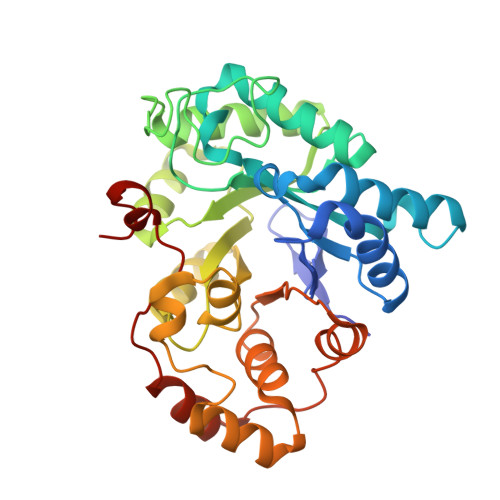The coenzyme specificity of Candida tenuis xylose reductase (AKR2B5) explored by site-directed mutagenesis and X-ray crystallography.
Petschacher, B., Leitgeb, S., Kavanagh, K.L., Wilson, D.K., Nidetzky, B.(2005) Biochem J 385: 75-83
- PubMed: 15320875
- DOI: https://doi.org/10.1042/BJ20040363
- Primary Citation of Related Structures:
1SM9 - PubMed Abstract:
CtXR (xylose reductase from the yeast Candida tenuis; AKR2B5) can utilize NADPH or NADH as co-substrate for the reduction of D-xylose into xylitol, NADPH being preferred approx. 33-fold. X-ray structures of CtXR bound to NADP+ and NAD+ have revealed two different protein conformations capable of accommodating the presence or absence of the coenzyme 2'-phosphate group. Here we have used site-directed mutagenesis to replace interactions specific to the enzyme-NADP+ complex with the aim of engineering the co-substrate-dependent conformational switch towards improved NADH selectivity. Purified single-site mutants K274R (Lys274-->Arg), K274M, K274G, S275A, N276D, R280H and the double mutant K274R-N276D were characterized by steady-state kinetic analysis of enzymic D-xylose reductions with NADH and NADPH at 25 degrees C (pH 7.0). The results reveal between 2- and 193-fold increases in NADH versus NADPH selectivity in the mutants, compared with the wild-type, with only modest alterations of the original NADH-linked xylose specificity and catalytic-centre activity. Catalytic reaction profile analysis demonstrated that all mutations produced parallel effects of similar magnitude on ground-state binding of coenzyme and transition state stabilization. The crystal structure of the double mutant showing the best improvement of coenzyme selectivity versus wild-type and exhibiting a 5-fold preference for NADH over NADPH was determined in a binary complex with NAD+ at 2.2 A resolution.
- Institute of Biotechnology and Biochemical Engineering, Graz University of Technology, Petersgasse 12/I, A-8010 Graz, Austria.
Organizational Affiliation:

















